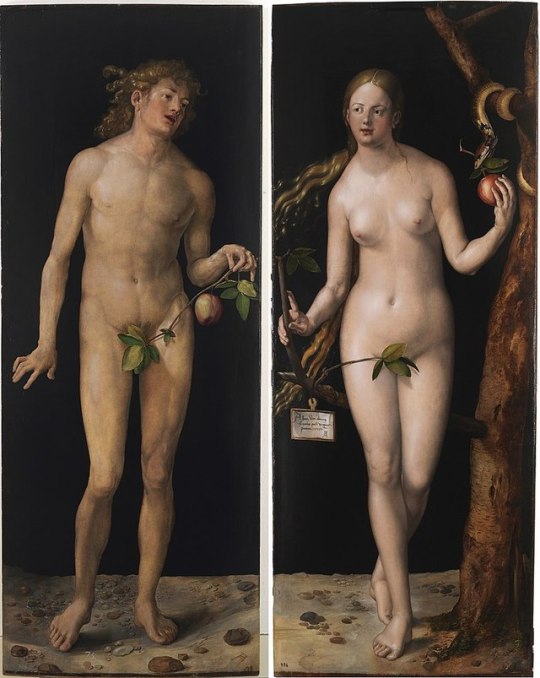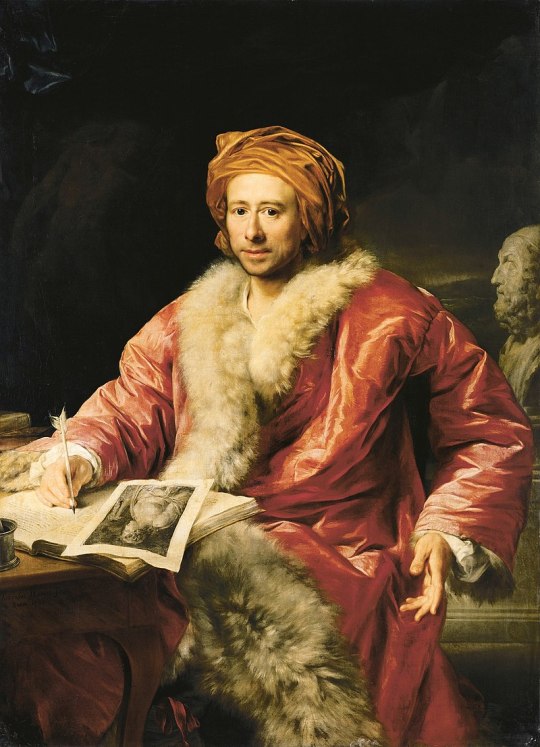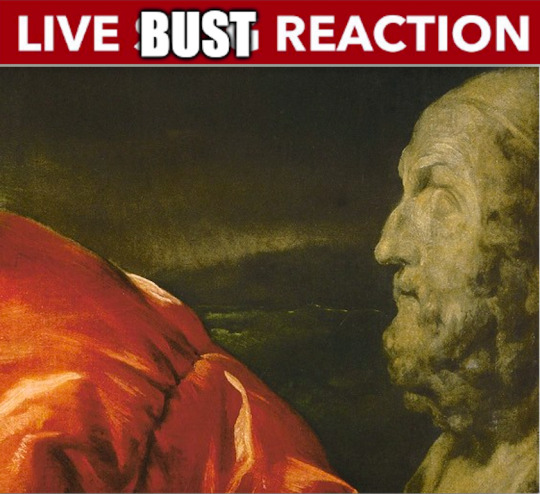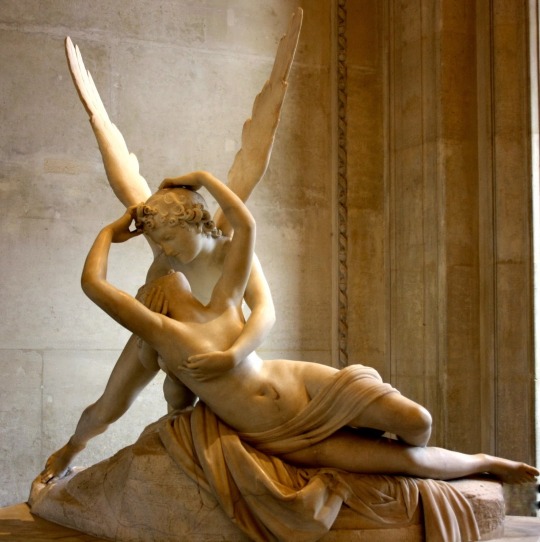#winckelmann
Explore tagged Tumblr posts
Text

From the Wikipedia page of Johann Joachim Winckelmann (1717-1768)
2 notes
·
View notes
Photo



Apollo
1 artist unknown, Roman copy (c120CE) of a Greek bronze after Leochares (c350BCE) marble 224cm
2 Marcantonio Raimondi (1470/82-1534) Italian The Apollo Belvedere from the Vatican his left hand resting on the tree trunk around which coils a python (c1510–27) engraving
3 Albrecht Durer (1471-1528) German Adam and Eve (1507) oil on panel, each 209x81cm
A metmuseum.org The Apollo Belvedere was discovered near Rome in the late fifteenth century. Possibly a second-century marble copy of a bronze original by the Greek sculptor Leochares, the statue was immediately appreciated as a masterpiece and showered with praise. Probably once in the private collection of Cardinal Giuliano della Rovere (later Pope Julius II, r. 1503–13), it was moved to the Vatican in 1509 and placed, in 1511, in the Cortile del Belvedere, from which it derives its name. Raimondi's print became an important vehicle through which knowledge of the statue was transmitted far beyond the Vatican. He is famous for his many engravings after the designs of Raphael, including images such as the Judgment of Paris (19.74.1), scenes that, like the Apollo, illustrate Renaissance interest in classical antiquity and mythology. Here, Raimondi's mastery for replicating the effects of light on marble produces a convincing impression of the statue's form. Many artists incorporated the Apollo's much-lauded pose into their own work. Albrecht Dürer reverses the position of the figure's limbs and Apollo becomes Adam, reaching for the fruited branch offered by Eve in the 1504 engraving . A similar figure of Apollo, whose outstretched arm grasps—too late—a fleeing nymph, appears in the 1625 marble group Apollo and Daphne by the Roman Baroque sculptor Gian Lorenzo Bernini (1598–1680).
B Johann Winckelmann (1717-68) Germany Of all the works of antiquity that have escaped destruction, the statue of Apollo represents the highest ideal of art. (1755)
#apollo#adam#eve#classical#contraposto#belvedere#Marcantonio Raimondi#raimondi#leochares#winckelmann#bernini
8 notes
·
View notes
Photo

APOLLO DEL BELVEDERE
‘Archeologia Romana’
All’epoca Stendhal fu quasi uno ‘spirito libero’ confessando di preferire le sculture del Partenone all’ ’Apollo del Belvedere’ tale era la misconcezione della vera natura dell’archeologia al suo tempo.
Anche noto come Apollo Pitico, è una celebre statua marmorea risalente al periodo post-ellenistico (seconda metà del II secolo d.C.) quando i Romani avevano conquistato tutta la Grecia antica. È tutt'oggi considerata per l'armonia delle proporzioni una delle più belle opere di tutta l'antichità, espressione del concetto di "bello ideale" (Definizione Estetica archeologica).
#archeologia#introduzioneall'archeologiaromana#ranucciobandibandinelli#apollo#apollodelbelvedere#winckelmann#stendhal#artegreca#arteromana
2 notes
·
View notes
Text
Johann Joachim Winckelmann 1717-1768
ein bedeutender deutscher Kunsthistoriker des 18. Jahrhunderts
wichtige Lebensstationen:
1. **Geburt und Jugend (1717-1738):** Winckelmann wurde am 9. Dezember 1717 in Stendal, Preußen, geboren. Seine Jugendjahre waren geprägt von seinem Interesse an Literatur und klassischer Bildung.
2. **Studium in Halle (1738-1748):** Winckelmann studierte in Halle klassische Philologie, Geschichte und Theologie. Diese Ausbildung legte den Grundstein für sein späteres Interesse an der Antike.
3. **Tätigkeit als Hauslehrer (1748-1754):** Nach seinem Studium arbeitete er als Hauslehrer, während er weiterhin seine Kenntnisse in Kunst und Antike vertiefte.
4. **Romreise (1755-1758):** Eine bedeutende Phase in Winckelmanns Leben. Seine Reise nach Rom ermöglichte ihm, die antike Kunst direkt zu studieren und beeinflusste stark seine kunsthistorischen Ansichten.
5. **Schriften und Werke (1758-1768):** Winckelmann veröffentlichte in dieser Zeit seine bedeutendsten Werke, darunter "Geschichte der Kunst des Alterthums" (1764), das als Meilenstein in der Kunstgeschichte gilt.
6. **Tod in Triest (1768):** Tragischerweise wurde Winckelmann in Triest ermordet. Sein Tod beendete sein einflussreiches Wirken, aber seine Schriften hinterließen einen bleibenden Einfluss auf die Kunstgeschichte.
Winckelmanns Leben war von einer tiefen Liebe zur Antike und einem bahnbrechenden Beitrag zur Kunstgeschichte geprägt.
0 notes
Text
Il concetto di imperturbabilità alla Winckelmann: “nobile semplicità e quieta grandezza”
1 note
·
View note
Text
There is an audio drama about Winckelmann. I have not yet listened to it in full, but there is a complete version (in German) on YouTube and it was produced by a public german broadcaster (mdr Kultur) and they normally manage to make quite good productions. Maybe someone is interested - and has enough knowledge about the matter to tell if it is actually good. :-)
youtube
Soon after that, while in Florence, Winckelmann experienced his first sexual encounters, which apparently involved no love attachments. The most astonishing report comes from none other than Casanova, who in 1761 surprised Winckelmann in his study: "I saw him withdrawing quickly from a young boy, at the same time readjusting his breeches. I pretended to have seen nothing." Winckelmann must have been mortified, because he offered a preposterous explanation to convince Casanova that he was not a pederast. Such "research" with young lads was his way to learn about the [ancient Greeks] more fully, he maintained: "I decided to enlighten myself through practice."
Worley, Michael Preston. "The love letters of J. J. Winckelmann." The Gay & Lesbian Review Worldwide (vol. 18)(no. 5) Sept.-Oct. 2011, p. 12.
#Youtube#reblog#my-deer-history#winckelmann#german#such an interesting person!#history#european history
25 notes
·
View notes
Text
Anyway heres my favourite portrait of Johann Winckelmann, a german scholar from the 18th century widely regarded to be the father of modern archaeology and art history

Not only is the robe and hairwrap absolutely fabulous, they also lend him a quite effeminate air. This was absolutely done on purpose by the artist, something that becomes obvious when you realise he is depicted studying a picture of Antinous

my favourite part?

36 notes
·
View notes
Text
“L'umiltà e la semplicità sono le due vere sorgenti della bellezza.”
— Johann Winckelmann
#umiltà#semplicità#sorgenti#bellezza#cose belle#frasi brevi#frasi e citazioni#frasi tumblr#frasi#Johann Winckelmann
32 notes
·
View notes
Photo

Superb Owl Monday
Congratulations to Patrick Mahomes and the Kansas City Chiefs for their 38-35 victory over the Philadelphia Eagles in 2023′s Super Bowl LVII! To celebrate, we present this rather smug-looking Great Horned Owl (Bubo virginianus) from a potential gift to our collection, an untitled collection of hand-colored lithographs produced by the noted Berlin lithography and publishing house Winckelmann und Söhne sometime between 1840 and 1860.
The firm was founded in 1828 by Johann Christian Winckelmann. It was particularly well known for producing children's books and educational plates, and it continued in operation for four generations until 1934. They were able to do color printing, but they also employed scores of youths who would hand color black and white lithographs, which is the case with this print.
A decision hasn’t been finalized, but we’re hoping that the luck of the Chiefs will rub off on us and we will soon see this volume as part of our collections.
View our previous Superb Owl posts.
View more motivated (and some unmotivated) owls.
#MondayMotivationOwl#owls#Superb Owl#Super Bowl#Super Bowl LVII#Kansas City Chiefs#Philadelphia Eagles#Patrick Mahomes#Great Horned Owl#Winckelmann und Söhne#Johann Christian Winckelmann#lithographs#hand-colored prints#hand-colored plates#hand-colored lithographs#lithography#birds#birbs!
64 notes
·
View notes
Text
Lessing says kissing your friends doesn't count

from "Die Küsse," in Lessing: Biografie einer Emanzipation by Dieter Hildebrandt.
#this and the way he writes about Winckelmann makes it painfully clear#there are two straight men in the Aufklärung and he is one#gotthold ephraim lessing#lessing#lessing: biografie einer emanzipation#dieter hildebrandt#die küsse#sherb's sub sub library
4 notes
·
View notes
Text
Here is a face I was not expecting to encounter in New York!

Johann Joachim Winckelmann by Anton Raphael Mengs (1777)
Winckelmann was a German historian and archeologist who played a significant role in teaching enlightenment Europe about ancient Greek and Roman art, and is one of those rare historical figures whose queerness is almost entirely undisputed. His profoundly stirring descriptions of masculine beauty in antique art pioneered a new way of understanding the ancient world, and his works were a touchstone for other queer people of the time.
#johann joachim winckelmann#18th century art#18th century history#queer history#me standing in the corner having a moment with jj and ignoring all the great masters around us 💕
5 notes
·
View notes
Text
Author: Sarah E. Bond Publication: Hyperallergic Timestamp: June 7, 2017 [roughly 9 years old]
Note: this is an article cited in the other one I made an extract for, but I think it's worth giving it its own post.
Extract:
Modern technology has revealed an irrefutable, if unpopular, truth: many of the statues, reliefs, and sarcophagi created in the ancient Western world were in fact painted. Marble was a precious material for Greco-Roman artisans, but it was considered a canvas, not the finished product for sculpture. It was carefully selected and then often painted in gold, red, green, black, white, and brown, among other colors.
[Several] museum shows throughout Europe and the US in recent years have addressed the issue of ancient polychromy. [For instance,] The Gods in Color exhibit travelled the world between 2003–15, after its initial display at the Glyptothek in Munich. [...]
Digital humanists and archaeologists have played a large part in making those shows possible. In particular, the archaeologist Vinzenz Brinkmann, whose research informed Gods in Color, has done important work, applying various technologies and ultraviolet light to antique statues in order to analyze the minute vestiges of paint on them and then recreate polychrome versions.
[...]
Most museums and art history textbooks contain a predominantly neon white display of skin tone when it comes to classical statues and sarcophagi. This has an impact on the way we view the antique world. The assemblage of neon whiteness serves to create a false idea of homogeneity [...] across the Mediterranean region. The Romans [...] did not define people as “white”; where [...] did this notion of race come from?
In early modern Europe, [...] the “scientific revolution” was marked by a desire to categorize, label, and rank everything from plants to minerals. [Inevitably,] humans were similarly subjected to such [man-made] systems of classification. [A]rtists began to engage with mathematics and anatomy and to use classical sculpture as a means [to replicate] beauty through proportions.
One of the most influential art historians of the era was Johann Joachim Winckelmann. He produced two volumes recounting the history of ancient art, Geschichte der Kunst des Alterthums (1764), [...] which came to form a foundation for the modern [...] art history. These books celebrate the whiteness of classical statuary and cast the Apollo of the Belvedere — a Roman marble copy of a Hellenistic bronze original — as the quintessence of beauty. Historian Nell Irvin Painter writes in her book The History of White People (2010) that Winckelmann was a Eurocentrist who depreciated people of other nationalities, like the Chinese or the Kalmyk.
[...]
Too often today, we fail to acknowledge and confront the incredible amount of racism that has shaped the ideas of scholars we cite in the field of ancient history.
[...]
If we want to see more diversity in Classics, we have to work harder as public historians to change the narrative — by talking to filmmakers, writing mainstream articles, annotating our academic writing and making it open access, and doing more outreach that emphasizes the vast palette of skin tones in the ancient Mediterranean.
I’m not suggesting that we go[...] repaint every white marble statue [...]. However, [...] better museum signage, [...] 3D reconstructions alongside originals, and the use of computerized light projections can help produce a contextual framework for understanding classical sculpture as it truly was.
It may have taken just one classical statue to influence the false construction of race, but it will take many of us to tear it down. We have the power to return color to the ancient world, but it has to start with us.
/end of extract
#white supremacy in classics#classical studies#antiquity#classical antiquity#ancient art#art history#arts and humanities#arts and culture#Sarah E. Bond#Hyperallergic#white marble#beauty#ancient Western world#polychromy#museum politics#whiteness#classical statuary#classical studies student#Johann Joachim Winckelmann#Apollo of the Belvedere#Nell Irvin Painter#human history#history#racism#academic discourse#ancient world#diversity in Classics#classical sculpture#consequences of the scientific revolution#old article
1 note
·
View note
Text
Edle Einfalt, stille Größe“
– dies geflügelte Wort gehört für Gebildete wie Halbgebildete zum Thema Klassik. Johann Joachim Winckelmann, der es prägte, ist als Wiederentdecker der Antike, Begründer der Kunstgeschichte und Inspirator von Dichtern und Denkern der Goethegeneration bekannt.
0 notes
Text

HISTRI in ISTRIA / Histri u Istri
Per la prima volta in Italia testimonianze del popolo degli Istri in mostra a Trieste
0 notes
Text



Esculturas de Antonio canova✨️
Su estilo estuvo inspirado en gran medida en el arte de la Antigua Grecia y sus obras fueron comparadas por sus contemporáneos con la mejor producción de la antigüedad, fue considerado el mejor escultor europeo desde Bernini. Su contribución en la consolidación del arte neoclásico sólo se compara a la del teórico Johann Joachim Winckelmann y a la del pintor Jacques-Louis David, aunque también fue sensible a la influencia del romanticismo.
#arte#photography#art#digital art#photographers on tumblr#culture#nature#design#beauty#illustration#cartoon#pinture#sculpture#home lifestyle#travel#fashion#books and libraries#books libraries
338 notes
·
View notes
Text

Cabeza de neno en basalto (s. I) da Colección Winckelmann
9 notes
·
View notes